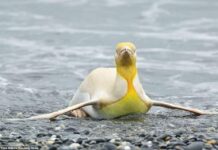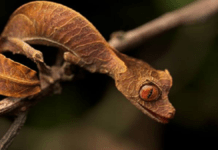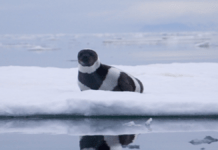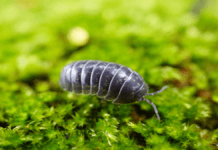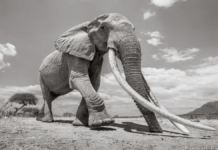Today I’m going to tell you about a special bird species in this world. Sometimes you may have heard about this one before. But in this article, I’m going to bring you some interesting facts you didn’t know before. The bird I’m going to tell you about is The King Vulture. It is a large bird that can be found in South America and Central America. This one lives in tropical lowland forests predominantly stretching from northern Argentina to Southern Mexico!
The Appearance of King Vulture

The king vulture is the largest new world vulture when excluding two condor species. Its weight ranges from 2.7-4.5 kilograms and its length ranges from 67-81 centimeters. Its wingspan ranges from 1.2-2 meters. Adult king vultures have white plumages with a slight rose-yellow tint on them. Flight feathers, wing coverts and tail colors vary from dark gray to black. Their neck and head are devoid of feathers and the head skin has red and purple shades. This is an adaptation for hygiene. The lack of feathers prevents bacteria from carrion and it exposes skin to the sun.

There is an irregular and highly noticeable golden crest attached to their black and orange bills. Relative to its size, the king vulture has the largest braincase, skull and strongest bill among the new world vultures. Their strong bills have sharp cutting edges and hooked tips. Unlike other new world vultures, the king vultures do not have eyelashes. They have white eyes bordered with the bright red sclera.
There is not much difference between male and female vultures. The females are a little bit small in the size and they have dark bills and eyes. Young king vultures are slate gray overall and they become similar to the adults in appearance when they are around three years old.
How about its distribution?

The inhabitation of The King Vulture is estimated at 14 million square kilometers between Northern Argentina and Southern Mexico. West of Andes, it does not live except in north-western Colombia, Western Ecuador and North-Western Venezuela. Their primary inhabitants are located in undisturbed tropical forests and grasslands and savannas nearby those forests. The king vulture is the only vulture who lives in lowland forests. But when it comes to Amazon rainforests, their population is outnumbered by turkey, American black vultures, greater yellow-headed vultures and lesser yellow-headed vultures. They usually live below 1,500 m. but at some places in the east of the Andes, they have been found at 2,500m altitudes.
What is their status?
According to the IUCN, the king vulture is categorized as the least concerned one. There are between 10,000 and 100,000 individuals within the estimated range of fourteen million square kilometers. But there are some pieces of evidence that show the decrease in their population. But it is not much strength to be listed. This decrease in the population has happened due to the destruction of their habitats.
How about their behavior?

The king vultures can soar in the sky for hours without effort and flap their wings infrequently. While they are flying, their wings are held flat and their tips are slightly raised. Their wing beats are very strong and deep. Despite their coloration and size, king vultures are inconspicuous when they are perched in trees. When they are perched, they hold their thrusts forward and their heads lowered.
They usually live alone or as small family groups, unlike turkey, American black vulture and yellow-headed vultures. Two or three birds usually gather together to feed on a carcass. But sometimes ten or more gather if there is a large amount of food. King vultures usually have long life spans. Most of them lived up to 30 years. One male vulture transferred to Queen’s zoo from Sacramento Zoo and lived around 47 years. But a female king vulture called Vivian turned 70 years old at Cameron Park Zoo in Waco this year.
The lifespan of these king vultures in the wild is unknown and they are unaggressive at killing despite their bill and large size. Usually, snakes are their only natural predators. Snakes pray upon young vultures and eggs. And also sometimes large cats surprisingly kill adult vultures at a carcass.
Their Reproduction?

The reproduction behavior of king vultures in the wild is not much known. The knowledge about their reproduction is gained from observing mature king vultures at the Paris Menagerie. A male king vulture sexually matures when it is around 4 to 5 years old. But female king vultures mature earlier than males. These birds mainly breed during the dry season. After mating, the female king vulture lays a single white egg in a nest in a hollow in a tree.
To protect eggs from predators, vultures keep nests foul-smelling. Until the egg hatches, both parents incubate the egg for around 52 to 28 days. The chicks have open eyes at their birth but they are helpless when they are born. Those chicks grow very quickly and by the second day of birth, they start to beg and wriggle around the nest. They stand on their toes by the 20th day and during the first three months, they walk around the nest and explore. They take their first flight when they are at the age of three months.
What do they eat?

Usually, they eat anything from a cattle carcass to a dead lizard. There are some incidents reported that king vultures killing and eating injured animals, small lizards and newborn calves. It uses vision to locate food and usually eats carrion found in the forest. When a king vulture finds a carcass, it displaces other vultures around it because of its strong bill and large size. King vultures make initial cuts in fresh carcasses using their strong bills. This provides opportunities for smaller and weaker vultures to access and feed the carcass after king vultures have fed. It pulls out the flesh from carcass’s bones using its rasp-like tongue. It normally eats harder parts of the tissue and skin for its meal.
King Vultures are nearly mute!
When king vultures are young, they make various sounds and even whistles. But when they grow older, they lose their ability to make sounds. The reason for this is that adult king vultures do not have ‘box voice’ which enables birds to make sounds without vocal cords. But when they want to show aggression, they do bill snapping and croaking.
What is their function in the ecosystem?

They play a vital role in the ecosystem as they feed on carrions. It helps to biodegrade potentially harmful carcasses. Biodegradation is usually done by microorganisms. But these king vultures help it. Biodegradation means transforming biological materials into products such as organic materials, carbon dioxide and water. It can be interpreted as transforming harmful biomass into environmentally safe components such as carbon dioxide and water. King vultures accelerate this process by reducing the carcasses of animals. It prevents dead animals from being rot and smelling for weeks while spreading diseases.
What are the treats that King Vultures have?
Losing habitats is the main threat that king vultures have. When wildlife loses their habitats, it reduces the number of carcasses. It means food items for king vultures become reduced. As king vultures avoid contact with humans, they do not have the possibility of being poisoned. Another main threat for king vultures is illegal hunting. Some local people are admitted to shooting king vultures just because of curiosity.
Why the King vulture’s neck, carbuncle and head are so colorful?

Most birds get colorful feathers and colorful body parts according to their sexual selection. In most cases, males have colorful plumages and females select more colorful males as their partners during the mating period. But when it comes to King vultures, both male and female birds have the same head, neck and carbuncle. So it disproves that the reason for their bright colors is sexual selection.
There are two theories regarding this colorfulness. According to the first one, these king vultures use colors on their neck and head to communicate their health and breeding conditions of them. According to the second theory, those bright colors indicate their social status. For example, young king vultures have dark plain heads and necks. So they are at the bottom level. Matured adult birds have bright colors on their neck and head and they gain a higher level of social status.
Do king vultures use their sense of smell to find dead animals?

It is not exactly proven that king vultures have a well-developed sense of smell. But they have a keen sense of light. However, some experiments have been done to test their sense of smell. One experimenter placed dead animals on the floor of a dense tropical forest. The first arrived bird to the carcasses was the king vulture. The only way they could find the carcass was the sense of smell. So it proved that they use the sense of smell to find dead animals.
Do the king vultures have an unresolved genealogy?
First of all, you must know that there is no relationship between old-world vultures and the king vultures. It is still unknown what birds are the close relatives of king vultures besides other vultures in America. King vultures have some behavioral traits related to storks and falcons. It suggests that king vultures, falcons and storks may be split from the same ancestors many years ago. A recent molecular study proved that king vultures are closely related to the Andean Condor, California condor and black-plumaged vultures of America.
They fly high and monitor other vultures below!

Usually, king vultures fly about 500 feet above other vultures and monitor whether they are congregating or flying in a certain direction. Those activities of smaller vultures indicate that they have found a carcass. So if the king vulture sees that other small vultures are heading in a certain direction, it descends at tremendous speed and reaches the carcass first.
King Vultures defecate on their own legs to cool off!
King vultures defecate on their own legs making them white. Ornithologists say that there are two reasons for this. The first one is they poop on their legs to release the heat. When their viscous liquid poop evaporates and dries, it absorbs heat from king vultures’ legs. The second reason is to protect from bacteria. The digestive juices of the King vulture can kill bacteria. So when they poop, it acts as an antibacterial. So they can keep their legs clean from bacteria that they collect while walking on rotten carcasses.

